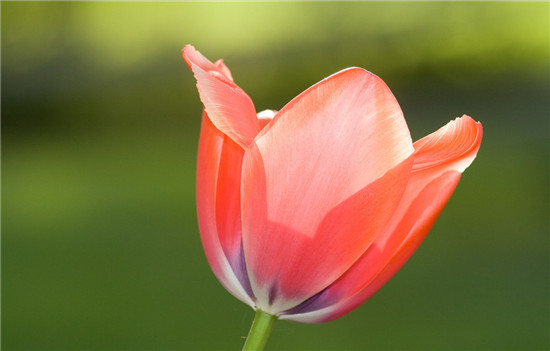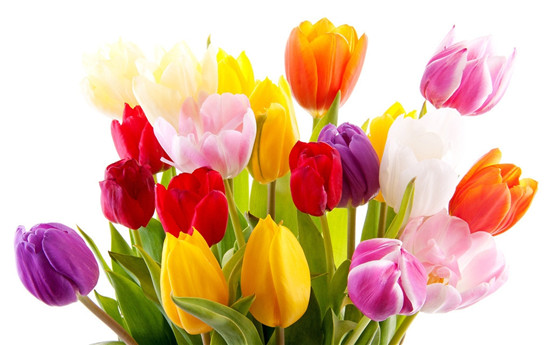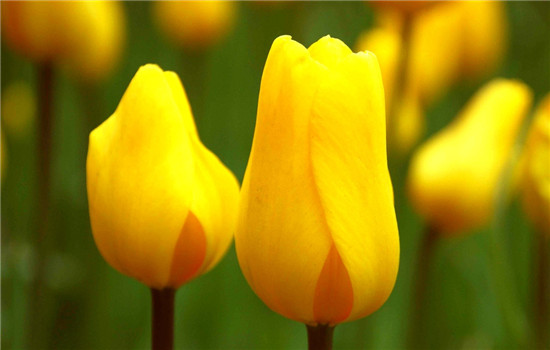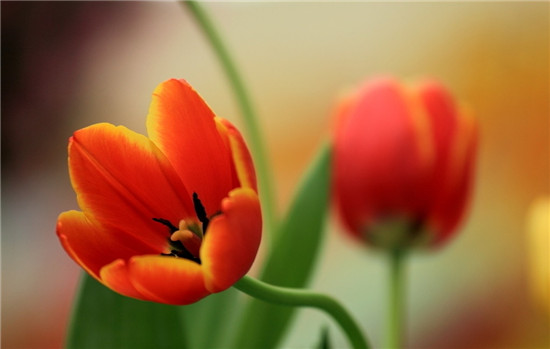[Dutch tulips] cultivation methods and matters needing attention of Dutch tulips
Tulips, also known as lotus flowers, belong to bulbs. What are the cultivation methods and matters needing attention of tulips? Let's go and have a look.

The Culture method of Tulip
1. Soil: tulips require both water retention and air permeability, the salinity should not be too high, and the pH value should not be less than 6. The mixture of peat, mature soil and sand with 1 ∶ 1 ∶ 1 as cultivation medium has a better effect.
2. Sunlight: sufficient sunlight is necessary for the growth of tulips. Insufficient sunlight will cause poor plant growth, cause sprouting, plant weakening, lighter leaf color and shorter flowering period. But tulips on the pot after more than half a month, should be properly shaded, in order to facilitate the growth of new roots. In addition, during germination, the elongation of flower buds is inhibited by light. Shading can promote the elongation of flower buds and prevent the early vegetative growth from growing too fast. After emergence, light should be increased to promote plant jointing, form buds and promote coloring. After the buds are fully colored in the later stage, direct sunlight should be prevented and the flowering time should be prolonged.
3. Temperature: tulips prefer warm winters and cool summers, and the optimum temperature for growth is 9-13 ℃. Strong cold resistance, can withstand the low temperature of-35 ℃ in winter.

4. Watering: water should be watered thoroughly after planting, so that the soil and seed bulbs can be fully and closely combined to facilitate rooting, water should be properly controlled after budding, leaves can be gradually elongated, water can be sprayed on the leaf surface to increase air humidity, and adequate water supply should be ensured at bolting and budding stages to promote the full development of flowers and proper water control after flowering.
5, fertilization: tulips do not have high requirements for fertilizer, if the growth is weak, you can apply some nitrogen fertilizer. When the root system is well developed, 2 kg of calcium nitrate is applied every 100 square meters, spread in three times, each time at an interval of more than one week.
6. Insect pests: the pathogens of tulip diseases and insect pests can be carried by the seed ball or by the soil, which mostly occur in the environment of high temperature and high humidity. the main diseases are stem rot, soft rot, broken color disease, quenching disease, blind bud and so on. most of the pests are aphids. Adequate soil disinfection should be carried out before planting, virus-free bulbs should be selected as far as possible, diseased plants should be dug up and destroyed in time, and fungicides should be poured 1-2 times in the growth process of the greenhouse, the effect is better; good ventilation should be maintained to prevent high temperature and humidity; when aphids occur, 3% natural pyrethrum can be sprayed 800 times.
Matters needing attention in tulip culture
In the middle and late ten days of April, most of the early flowering varieties are nearing the end of flowering and the petals begin to wither, while the middle flowering varieties enter the full flowering stage. When the temperature exceeds 28 ℃, the cut flower quality of most tulip varieties will be affected. The environmental temperature should be controlled at 10-20 ℃, so as to ensure the normal flowering of the plant, and too high temperature will make the plant appear "dumb bud". When the temperature was 20-25 ℃ in the first ten days of May, the plants began to bear fruit in large quantities. In late May, with the increase of air temperature, the leaves began to wither and yellow, and the renewal bulbs gradually matured. At the beginning of June, the temperature was sometimes as high as 25-30 ℃, the root system died gradually, the fruit changed from green to yellow, the capsule cracked, the seed matured and the bulb entered the dormancy stage.

Tulip seeds like to germinate at low temperature. Generally, seeds begin to germinate at about 5 ℃, and 7-9 ℃ is the best. The germination rate is high, germination is delayed over 16 ℃, and no germination is over 25 ℃. Under suitable conditions, the germination rate is more than 90%. If the seeds are refrigerated at 8-10 ℃ for 30 days before sowing, the seeds germinate better. The optimum temperature for seedling growth was 13 ℃, and then controlled within 25 ℃.
When tulips are cultivated in the greenhouse in winter, the temperature and humidity in the greenhouse are mainly regulated by ventilation to maintain the best temperature for stem and leaf growth and budding and flowering. At the same time, in the bulb storage period, ventilation is also used to adjust the room temperature to reduce the chance of disease and insect infection.
The tulip flowerpot rotates, because the plant has phototaxis, we should often turn the flowerpot so that the stem can grow upright without tilting, and the whole plant grows symmetrically and beautifully.

Tulips like to be rich in humus, well-drained sand or sandy loam, so planting tulips should choose plots with high terrain and smooth drainage. The day before planting (covering the film for more than 7 days), open the film, poop soil fine, the terrain should be slightly higher in the middle and slightly lower around. To facilitate drainage.
The above is the whole content of the cultivation methods and precautions of Dutch tulips that I have summarized for you. I hope this article can help you. Please continue to follow us.
The day before planting (covering the film for more than 7 days), open the film, poop soil fine, the terrain should be slightly higher in the middle and slightly lower around. To facilitate drainage.
The above is the whole content of the cultivation methods and precautions of Dutch tulips that I have summarized for you. I hope this article can help you. Please continue to follow us.
- Prev

[how to raise Phalaenopsis] how to raise Phalaenopsis after flowering
[how to raise Phalaenopsis] how to raise Phalaenopsis after flowering
- Next

[butterfly orchid florescence] how long is the butterfly orchid florescence?
[butterfly orchid florescence] how long is the butterfly orchid florescence?
Related
- Wuhan Hospital Iron Tree Blooming Result Was Instantly Frightened by the Gardener Master
- Which variety of camellia is the most fragrant and best? Which one do you like best?
- What is the small blue coat, the breeding methods and matters needing attention of the succulent plant
- Dormancy time and maintenance management of succulent plants during dormancy
- Minas succulent how to raise, Minas succulent plant pictures
- What are the varieties of winter succulent plants
- How to raise succulent plants in twelve rolls? let's take a look at some experience of breeding twelve rolls.
- Attention should be paid to water control for succulent plants during dormant period (winter and summer)
- Watering experience of twelve rolls of succulent plants
- Techniques for fertilizing succulent plants. An article will let you know how to fertilize succulent plants.

